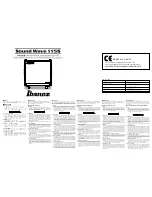
diagram in Fig. M, the output
of the variable-gain tube stage
drives
analog
buffered
outputs, including an effects
loop send output and a 20 dB
padded tuner output. Actual
measurements of our test amp
shown the tuner output to be
padded by 12 dB, compared
to the effects send. The
output of the variable-gain
tube stage also feeds an analog
stage that enables parallel
mixing of the input signal
with the effects return (if the
effects loop is configured for
parallel operation) or buffering
of the effects return, if the
effects loop is configured for
series operation.
The output of the buffer/
mixer drives the equalizer
section. The equalizer section
is set on a circuit board, seen
in Fig. C. The output of the
equalizer drives an additional
analog gain stage controlled
by the Master volume control
on the front panel. The
output from the Master
control passes through a
limiter before reaching the
tube phase inverter.
The EC083 tube phase
inverter receives the signal
from the limiter and creates
two copies of the signal out of
phase with each other. Each
output of the phase inverter is
buffered by a corresponding
ECC099, which ensures that the signal
has sufficient capability to drive its half of
the KT-88 sextet.
The Classic 300 also features a handy
footswitch input on the front of the
chassis for controlling a mute function.
The mute affects the speaker outputs as
well as the DI output. However, the
tuner, effects send, and effects return are
not affected by the mute function. The
effects loop in the Classic 300 is
implemented pre-tone stack and after the
initial tube gain stage. Moreover, the
effects loop on our test unit was
configured for parallel operation.
However, there is no effects loop bypass
or control over the blending of the
parallel loop. During testing of the effects
loop, a wire jumper was installed between
the send and return jacks, a sine wave was
input into the amp, and the output of the
amp was monitored at the speaker
output. The signal level increased by
about 6 dB with the wire jumper in the
effects loop, compared to the output with
no wire jumper in the effects loop. This is
precisely what was expected as the wire
jumper essentially mixes in parallel, two
copies of the same signal, thus creating a
voltage gain of 2. As with all parallel
effects loops, the typical caveats apply.
Users should pay attention to make sure
that any utilized effect returns a signal in-
phase. Also, certain digital signal
processors induce a delay into the signal
path that may affect the quality of the
effect when blended back in with the
original signal.
Fig. L – Optimally Flat at Speaker Output (red) compared to the
Effects Send (green) and Effects Return (blue)
Fig. K– Low Frequency Sweep – High Fidelity Setting
Fig. J – Mid Low Frequency Sweep – High Fidelity Setting
Fig. I – Mid High Frequency Sweep – High Fidelity Setting
Fig. M – Flow diagram
Содержание CL 810
Страница 1: ...56 bass gear by Tom Bowlus...
































